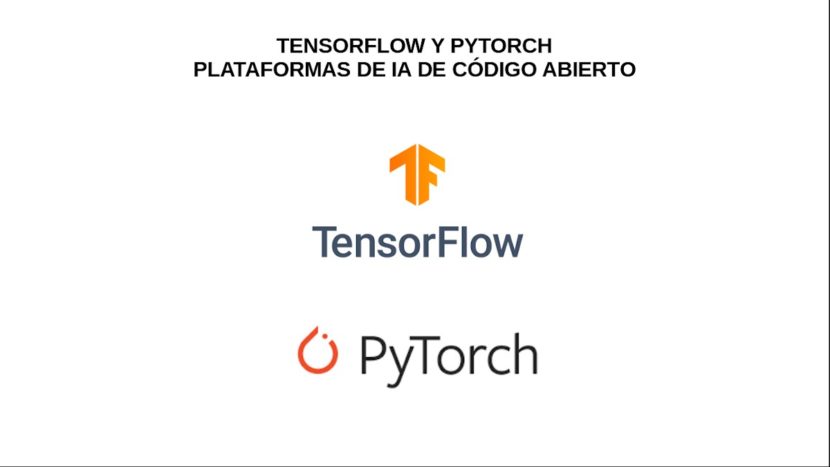
TensorFlow and Pytorch: Open Source AI Platforms
TensorFlow and Pytorch are 2 platforms «Inteligencia Artificial (IA)» de «Código Abierto». The first was created by Google and the second is widely used by Facebook. But, What is Artificial Intelligence? La «IA», as we mentioned in a previous article called "Fourth Industrial Revolution: The role of Free Software in this new era" is one of the many new technologies that are currently changing the course of our XNUMXst century digital society.
In a nutshell, you can describe the «IA» and technology resulting from combination of algorithms designed for the purpose of create machines (software) that present the same capabilities that human.

La «IA» makes it possible for machines learn from their own or other people's experience, adapt and adjust to new knowledge and lived situations, and perform tasks as any other human would. In addition, this technology is usually accompanied or by the hand of others, especially 2 known as «Aprendizaje Profundo (Deep Learning)» y «Procesamiento del Lenguaje Natural (Natural Language Processing)». And the «Big Data» it is also widely used in it.
In such a way, that these technologies allow current computers and robots, and probably one day Androids, to be effectively and efficiently trained, to carry out specific tasks such as processing large amounts of data, recognizing patterns in data, performing or solving play or work activities, moving around (self-driving) or moving objects to different places, among many other things.
Types of Artificial Intelligence (AI)
In short, AI can be very useful to create:
- Systems that think like humans: For automate the performance of activities, such as: decision making, problem solving and learning. Example: Rartificial neural edes.
- Systems that act like humans: To create machines that perform tasks similar to how people do. Example: Robots and Androids.
- Systems that think rationally: For emulate the rational logical thinking (perceive, analyze and act) of humans. Example: Sexpert systems.
- Systems that act rationally: For rationally emulate the human behavior. Example: Slabsmart people.
Open Source AI Platforms

TensorFlow: What is it and what are its characteristics?
- It is the most used Artificial Intelligence platform in the world
- It was created by Google (Brain) for internal use and released under the Apache 2.0 open source license on November 9, 2015, replacing its closed source predecessor, DistBelief.
- It is formed as an open source library aimed at deep learning, which is also available for Windows, Linux, MacOS, and mobile platforms that include Android and iOS.
- Its objective is to satisfy the needs of systems capable of building and training neural networks to detect and decipher patterns and correlations, analogous to the learning and reasoning used by humans.
- It is currently used for both research and production of Google products, replacing the role of its closed source predecessor, DistBelief.
- Its name comes from the operations performed by the neural networks of this system on multidimensional data arrays that are usually called: Tensors.
Note: More information about her can be obtained from her Official website.

Pytorch: What is it and what are its characteristics?
- It is the second most used Artificial Intelligence platform in the world.
- Well known for being Facebook's premier library for deep learning applications.
- It is a Python package designed to perform numerical calculations using the programming of tensors. In addition, it serves as a replacement for the Numpy package.
- It allows its execution on GPU to speed up the calculations performed. It internally uses CUDA, an API that connects the CPU to the GPU that has been developed by NVIDIA, which allows to accelerate traditionally slow processes such as model training.
- It is widely used in research and development processes in the field of deep learning, mainly focused on the development of neural networks, through a very simple interface.
- PyTorch works with dynamic graphs instead of static ones.
- You need to know the programming language "Lua" to make use of it.
Note: More information about her can be obtained from her Official website.
Alternatives available

Conclusion
We hope you are "small but useful post" about these 2 interesting «Plataformas de Inteligencia Artificial (IA) de Código Abierto» calls «TensorFlow y Pytorch», which are for now, in which almost all AI experts around the world work, are of great interest and utility, for the entire «Comunidad de Software Libre y Código Abierto» and of great contribution to the diffusion of the wonderful, gigantic and growing ecosystem of applications of and for «GNU/Linux».
And for more information, always do not hesitate to visit any Online library as OpenLibra y jedit to read books (PDFs) on this topic or others knowledge areas. For now, if you liked this «publicación», don't stop sharing it with others, in your Favorite websites, channels, groups, or communities of social networks, preferably free and open as Mastodon, or secure and private like Telegram.
Or simply visit our home page at DesdeLinux or join the official Channel Telegram from DesdeLinux to read and vote for this or other interesting publications on «Software Libre», «Código Abierto», «GNU/Linux» and other topics related to «Informática y la Computación», and the «Actualidad tecnológica».